ANSI/TIA-568-C testing LC to SC (Duplex Multimode) DTX-MFM
Last date of manufacture: March 31st, 2006
Replacement product: DTX-EFM2
If you are applying for a cabling warranty, please check with your vendor in advance to see if this method is still acceptable.
This article will describe the steps required to successfully certify a multimode LC to SC duplex fiber link in accordance with ANSI/TIA-568-C using the DTX-MFM fiber adapters. ANSI/TIA-568-C requires the user to follow Method B (also known as 1 Jumper) which ensures that the connectors at each end of the link are measured. A 1 Jumper Reference is not possible with these adapters, so an adapted method is used.
Items required in addition to a DTX CableAnalyzer:
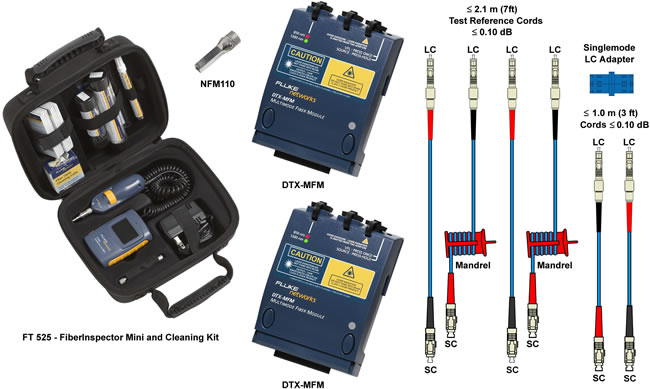
클리닝은 필수입니다. It is the single most reason for ending up with negative loss values. You cannot clean without some means of visually inspecting the end face. This can be anything from a simple Fiber Viewer to a Video Scope such as the FiberInspector Mini shown above. If you have no inspection device, you cannot proceed. Let's define what is acceptable and not acceptable.
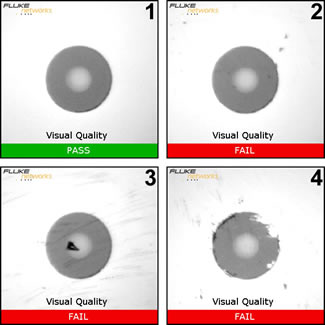 |
|
The Test Reference Cords (TRCs) are critical to a successful measurement. Your multimode TRCs loss should not exceed 0.20 dB at each end. And yes, you must inspect and clean these TRCs every time you use them - even new ones out of the bag.
Where did Fluke Networks get that 0.20 dB requirement?
ANSI/TIA-568-C does not specify a maximum loss requirement for TRCs. However, IEC 14763-3 does and that's where the 0.10 dB for multimode and 0.20 dB for singlemode comes from.
In this example, we're going to test a 100 m (328 ft) duplex 50/125 µm multimode fiber link with LC connectors at one end an SC connectors at the other end to ANSI/TIA-568-C.
Setting up the DTX CableAnalyzer
-
With the fiber modules inserted into the DTX CableAnalyzer, power up the main and remote units.
Sources will need at least five minutes to stabilize, longer in colder or hotter environments.
-
Rotate the dial on the DTX CableAnalyzer to SETUP.
-
Change the Test Limit to TIA-568-C Multimode.
-
Change the Fiber Type to the cable you are testing.
This setting changes the Refractive Index (n) value. The DTX uses n to calculate the length of the fiber. You can manually enter the n values in Tab 3 of the Setup. If you cannot find your cable in the DTX Cable Library, look to the cable vendor's website for their datasheet. Since the TIA-568-C Multimode limit is calculated based on length, it is important to get this value right.
-
The Number of Adapters is going to be 2.
This is always the number of adapters per fiber strand added after the reference has been set.
-
Set the Connector Type to Mixed.
This will not affect the outcome of the result. It only affects the help screens and is of course recorded with the test result.
-
Set the Test Method to 1 Jumper. (Our reference will involve 2 Jumpers, but the result willl be equivalent to the 1 Jumper method)
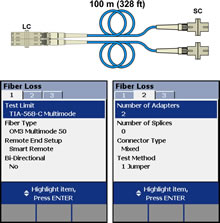
-
Clean AND inspect the TRCs.
-
Connect the main and remote units together as shown below with a singlemode rated adapter.
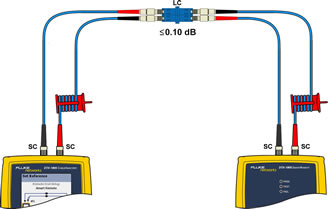
Mandrels must be used. It is a requirement of ANSI/TIA-568-C. Failure to do so can result in good fiber links failing. Red and grey mandrels are shipped with the fiber modules from Fluke Networks. The red is for 50/125 µm and the grey is for 62.5/125 µm TRCs.
-
Rotate the dial to SPECIAL FUNCTIONS.
-
With Set Reference selected, press ENTER then TEST.
-
You will then be presented with the results of the Reference.
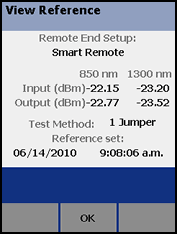
For 50/125 µm it should be better than -24.50 dBm where -23.50 is better than -24.50 dB.
For 62.5/125 µm it should be better than -20.00 dBm where -19.50 dBm is better than -20.00 dBm.
These values reflect the cleanliness of the Ports and TRCs. The fact that your reference values are better than the minimum stated above does not mean they are good/clean.
-
Press F2 OK.
-
You can enter the length of your TRCs here. It does not affect the outcome of the test, but will be displayed on the test report. #3 is the short patch cord we are about to add.
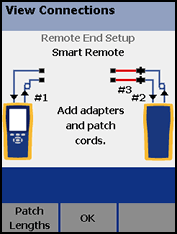
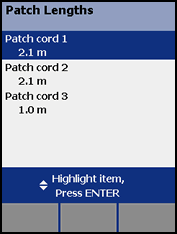
-
Press F2 OK when done.
-
Disconnect the remote unit from the main unit.

-
Insert the short SC to LC TRCs on the remote unit. (Can be on the main or remote unit)
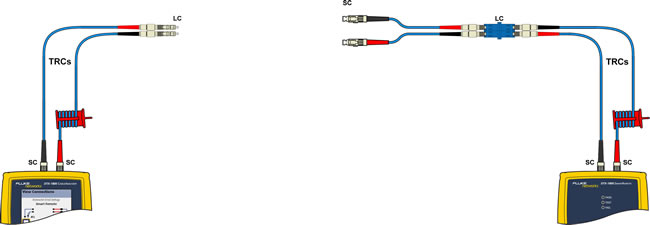
This adds back in the mated connection that was just referenced out so that our Adapter Count is 2 and not 1. If you did not add the short SC to LC TRCs, then it would be a Method A reference which is not permitted in ANSI/TIA-568-C and the Adapter Count would be 1.
-
Connect the TRCs to the link you're testing.
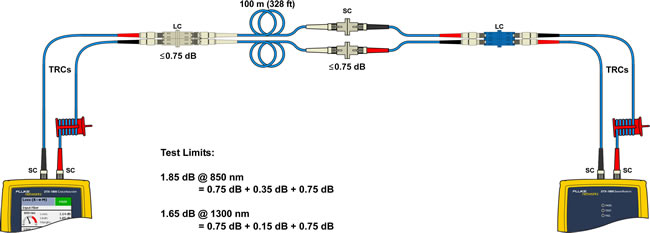
-
Rotate the dial to AUTOTEST Press TEST.
The DTX CableAnalyzer will calculate the test limit (optical loss budget) for you. Changing the number of adapters/splices will of course increase the test limit. Be sure the Number of Adapters is set correctly.
How often should I Set Reference?
The quick answer is; every time you begin to test a series of fiber links. It is critical to continually inspect the TRCs.




